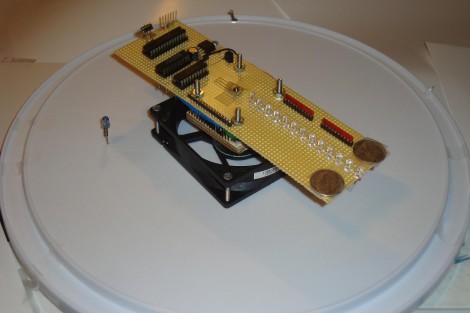
We love spinning POV displays but have yet to build one to call our very own. This project might be the one that we end up building. It’s looks good and it’s the only persistence of vision display that comes to mind which can be built in twelve hours.
The spinning is taken care of by a PC fan. This actually helps with some of the calculations as this fan spins at a know RPM. That information, along with a bit of geometry, can be used to calculate the timer interrupts for syncing the display. A reference point for this device is provided by an IR receiver/emitter pair which is easy to wire up since you already need a voltage source for the fan itself. The rest of the hardware is pretty common: a battery holder is centered on the axis for proper weight distribution and protoboard houses the components such as a PIC 18F252, 74LS373 data latches, and the LEDs themselves. The circuit is wire-wrapped, and works like a charm as evidenced in the clip after the break.
[youtube=http://www.youtube.com/watch?v=KWx7Jezz0rM&w=470]
[via Hacked Gadgets]














nice, maybe it would look better if the leds were closer together.
Won’t the fan burn out faster with the extra load? there ought to be more wind resistance than it’s built for.
some day i need to build a POV display into a hub-cap.
Nice design, could use brighter LEDs though.
Should have used a Propeller. The design would have really took off then, plus I’m sure the 12 hours would just fly by.
@holly – Propeller would be overkill, methinks (even more than using an Arduino).
This looks good! A couple of suggestions would be to use SMD LED’s (smaller, less height), and then do this on an -actual- DC powered FAN. Even if you need to slow the fan down, that’d still be slick. (I’ve seen one where the chips were moved off the blades, but this would be tricky work).
A few years back there was a ($300 +) ThinkGeek fan populated with RGB LEDs, and you could upload small color images to it which is still pretty novel.
Surface mount LEDs? Don’t talk wet kid.
nice project. Agreed it could be taken from concept level to polished design with smaller or hidden components.
@alan – was your post deliberately intended as a contribution-less troll? Moving on…
If anyone wants to study a second example of this type of thing for study, see the Adafruit SpokePOV (which is ATTiny-based, and uses a Hall sensor so it could work under bright light).
@jaquen
This may be what your looking at http://www.youtube.com/watch?v=CkBPQwxHupA
It is a commercial product but surprisingly well finished. Although at $20k + for a set of four i cant see many people investing in them…..
@jaquen : These hubs are fun as a concept but you are right, it’s not $20K well spent: given that you drive 99% of the time on public roads, where non-standard lights are illegal, these will be off 99% of the time, all the while picking up 100% of the rain and road dust/salt/what have you.
And what a distraction! In my town they are talking about removing RGB LED billboards because people just get mesmerized by them and stop watching the road. These hubs will have the same effect, I think.
Hey how you programmed it to draw and write such things